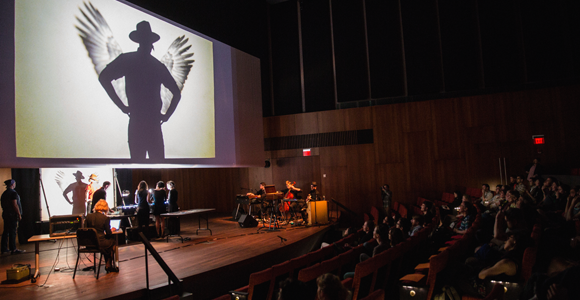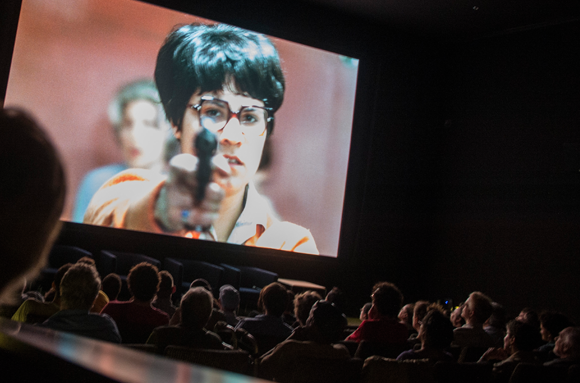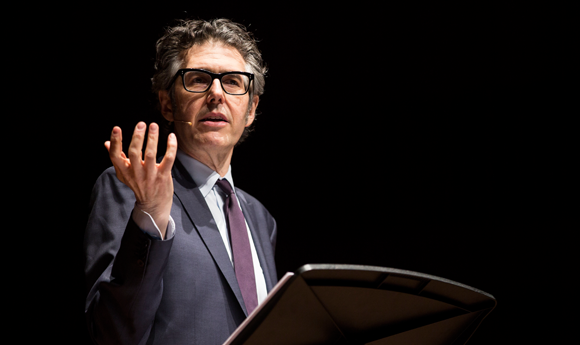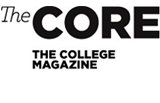
Working overtime
A three-day Studs festival packs in the stories.
Photography by Megan Doherty, AM’05, PhD’10; Robert Kozloff; and Andrew Nelles
In May the University’s Logan Center for the Arts hosted “Let’s Get Working,” a festival honoring the work and influence of oral historian Studs Terkel, PhB’32, JD’34. The festival was organized by Leigh Fagin of the Logan Center; Paul Durica, AM’06, PhD’13, creative writing instructor and local historian; and Judy Hoffman, professor of practice in the visual arts, whose early work was deeply influenced by Terkel.
Like Terkel’s own interviews, the wide-ranging festival included anyone who had something interesting to say, from radio celebrities to high school poets. To cover the festival—with its concurrent sessions and late-night events—the Core dispatched a small army of writers; here’s a sampling of what we saw and heard.—Carrie Golus, AB’91, AM’93

Friday
4 p.m. | Medium Cool screening and conversation
7 p.m. | Our Man in Chicago: Studs Terkel
I heard that my friends, the hippies, were going to come to Chicago to demonstrate against the war,” says Haskell Wexler, the 92-year-old director of Medium Cool (1969), before a screening of his genre-defying film. Medium Cool intersperses documentary footage throughout the fictional story; at its climax, lead character Eileen wanders through the carnage of the very real protests outside the 1968 Democratic National Convention.
After the screening there’s an hour-long pause for the opening festival reception in the performance penthouse (drinks include the “Spuds Terkel” cocktail, based on potato vodka); then it’s back down to the screening room to discuss the film.
English professor James Chandler, AM’72, PhD’78, recalls watching Medium Cool as a student at Notre Dame: “We were all puzzled about what we had just seen.” How could a fictional character be part of documentary footage? Through special effects? No. Wexler, expecting a riot, had planned his filming schedule to coincide.
Terkel, a lifelong friend of Wexler’s, helped make the film possible: in the credits he’s listed as “our man in Chicago.” Wexler grew up in Chicago but had not lived here for decades; he relied on Terkel to bring him up to date.
It was Terkel who took Wexler to Uptown to show him the crushing poverty of its recent Appalachian migrants. So Wexler created Eileen, a single mother who lives in Uptown with her son Harold. He named Harold for the real-life Harold Blankenship, the actor who played him; Wexler had discovered Blankenship on the street.—Carrie Golus
8 p.m. | It’s a Living screening
In the 1960s the first portable video camera came on the market. “It was kind of a utopian moment,” says UChicago video teacher Judy Hoffman: a relatively cheap and accessible technology, quickly adopted by activists, coincided with a revolutionary time. “We wanted to change corporate media,” she says. “We called ourselves ‘the alternative media movement.’”
Out of this milieu came the 1974 video It’s a Living, an homage to Terkel’s oral-history book Working: People Talk about What They Do All Day and How They Feel about What They Do, published three years earlier. Hoffman worked with a group of collaborators—including Tom Weinberg, now of the independent video archive Media Burn, which has preserved much of Terkel’s television work—to capture the lives of working people, as Terkel had done. The video features a parking-lot attendant, WFMT’s receptionist (at one point she cries in frustration), a barber, a piano tuner, a model, a waitress, and Terkel himself, who was a challenge, Hoffman says: “How do you interview the interviewer?”
The camera and unnamed interviewer follow Terkel through a workday at WFMT. There’s Terkel in the sound booth, wrapping up his hour-long radio show (opening a matchbook to light a cigar even as he’s still talking); in the storage room with the shelves of reel-to-reel tapes he’s recorded over the years; at a table in the Billy Goat Tavern, quoting an interviewee from Working: “The jobs are not big enough for people’s spirit.”
It’s a Living aired first on WTTW, then was picked up nationwide. By today’s standards it’s rough. Outdoor sound is terrible; the boom mike occasionally pokes into the shot. “You’ll excuse the production values,” says Hoffman, “but you know what? We didn’t give a crap about production values.”—Carrie Golus
9 p.m. | Conversation with Dave Isay and Alex Kotlowitz
More than a few audience members are yawning as StoryCorps founder Dave Isay and writer and documentarian Alex Kotlowitz discuss Terkel’s influence on their work—but not out of boredom. The event, running 30 minutes behind schedule, is a little late for the public radio crowd, but the audience perks up as Isay and Kotlowitz play audio and video clips from their work and swap remembrances of Studs.
“He was just fully engaged, all the time, with everybody,” marvels Kotlowitz, author of There Are No Children Here (1991) and Never a City So Real (2004).
Studs’s work is in the DNA of StoryCorps, a radio project dedicated to capturing the stories of everyday people. “The act of being listened to can be an important and transformational act in a person’s life,” Isay says. “It’s this crazy experiment in human connection.”
Kotlowitz recalls a radio documentary he produced about Milton Reed, who painted murals for families in the Robert Taylor Homes. (Common requests included landscapes, panthers, and Jesus—for a modest fee of $50 to $100.) Despite his influence on his community, the interview with Kotlowitz was the first time he had spoken about his work publicly. The reason? “Nobody ever asked.”—Susie Allen, AB’09
Saturday
10 a.m. and ongoing | Media Burn Archive’s Best of Studs
“Chicago is a city of hands,” Studs Terkel says in a clip from Media Burn’s video compilation The Best of Studs: 1946–2008. “It was the muscle of Chicago that built this town.”
And for 90 minutes, it’s the voices and faces of Chicago that light up a darkened classroom in the Logan Center, all talking to Terkel. There he is interviewing Nelson Algren. Talking with music critic Dave Marsh about blues musician Little Walter. Rallying in support of Harold Washington back in 1983. Taking instruction from a Spanish-speaking waiter on the correct way to say nada.
Watching Terkel chat with former White Sox owner Bill Veeck over beers at the Billy Goat, it’s hard to imagine a more typically Chicago scenario—unless the two had also been eating ketchupless hot dogs and putting lawn chairs in their parking spaces.
There are scenes from Studs’ Place, the unscripted drama in which he starred in the late ’40s and early ’50s. And there are highlights from his memorial service in 2009, featuring, among others, Roger Ebert, EX’70; historian and activist Timuel Black, AM’54; and filmmaker Haskell Wexler.
Another clip features Terkel in a library author talk with actress and playwright Anna Deavere Smith in 2000. At one point Smith delivers a five-minute monologue as Terkel: she rails about the media’s obsession with Monica Lewinsky, corporate greed, and the lack of courage shown in fiction since The Adventures of Huckleberry Finn. Terkel himself watches in delight.
“Sometimes people don’t like the questions we ask,” Deavere Smith tells Studs before she begins. “But we ask ’em anyway.”—Jeanie Chung
10 a.m. | Terkel Talk with the Illinois Labor History Society: Skilled Hands, Old and New
How many of you have worked for pay?” asks Susan Gzesh, AB’72, of the University’s Human Rights Program. All two dozen hands in the Logan Center classroom shoot up. “Part of a labor union?” The youth (myself included) lower their hands. “Your parents were part of a labor union?” Only three hands left.
Most of us, then, needed Illinois Labor History Society director Larry Spivack’s refresher on the Chicago Haymarket affair. On May 4, 1886, America’s first major labor rights movement came to a head when seven police officers and four demonstrators were killed during a rally for the eight-hour workday. International Workers’ Day commemorates the incident, which has been a touchstone for the labor rights movement since.
“All you have to understand about why Americans don’t know this story is that it’s not told,” says Larry Spivack, who directs the Illinois Labor History Society that Studs Terkel cofounded. Terkel spent his career telling the story of labor, Spivack says, both in his oral histories and through his underrated activism.—Derek Tsang, ’15
12 p.m. | WFMT’s Making Radio with Studs and the Studs Terkel Radio Archive
Two things become clear as Studs Terkel’s WFMT colleagues look back on his long career at the station: Terkel may have been beloved and admired, but he was something of a handful.
Terkel’s longtime assistant Sydney Lewis recalls meeting her future boss for the first time while working as a waitress at the Quiet Night, a club in Lincoln Park. When Lewis came for his drink order, Terkel began chewing her ear off. An exasperated Lewis finally told him, “I read Working, I love Working—but I am working.”
He could be sensitive to slights. When Richard Nixon’s enemies list came out in 1973, Terkel was horrified to discover he was not on it. “He didn’t talk about anything else for days,” WFMT music director Andi Lamoreaux remembers with a laugh.
Terkel’s garrulous manner and penchant for smoking cigars in the office drove his colleagues crazy, but he made up for it with his deep dedication and generosity. If a friend was short of money, Terkel would quietly slip him a check. A dedicated husband, Terkel called his wife Ida, PhB’33, after every show. “She was the audience that mattered most to him,” Lewis says.
Late in his life, Terkel worried he would be forgotten. Looking out over the crowd, Lewis smiles. “This would make him so happy.”—Susie Allen
1 p.m. | Craft Talk with Community Media Workshop: Journalism
As former Chicago Sun-Times writer Dave Hoekstra talks shop with the Community Media Workshop’s Thom Clark, I can’t help but feel a twinge of jealousy. They both have books in the works and spent their careers in the pre-click-bait era. “I don’t know that Studs would have liked the speed and superficiality of social media,” says Hoekstra.
That tidbit sent the audience—mostly fellow aspiring journalists from campus publications, and the only group all day taking notes—into our Moleskines. As much as we’re striving to emulate the panelists, they strive to emulate Terkel, both professionally and personally.
“Studs had a very broad notion of what politics meant, and what storytelling could do,” says Mary Schmich of the Chicago Tribune, recalling that Terkel introduced her to Margaret Atwood as the writer of a column that “wasn’t political, but was. He understood that the stories you chose to tell made political statements.”—Derek Tsang
5 p.m. | Show & Tell: A Manual Cinema production with audio stories provided by StoryCorps
Shadow puppetry” doesn’t begin to describe what Manual Cinema accomplishes with its small ensemble of performers and three humble overhead projectors. Through a carefully choreographed combination of projected cutout puppets, live-action performers, and original music, the Chicago-based ensemble creates truly cinematic animated pieces in real time.
“There isn’t anything like what they do,” Heidi Coleman, AM’08, of Theater and Performance Studies, recently told the Chicago Tribune. “They are inventing something.”
For “Let’s Get Working,” Manual Cinema debuts Show & Tell, which brings to life audio interviews from the StoryCorps archive. The stories range from the lighthearted—Terkel recounting the indignities of a trip to the airport, the tale of a young musician taking up the trombone—to the raw and emotional. In one, two daughters interview their aging father about his memories of their childhood. In the final piece, a man looks back on falling in love with his late wife.
By the end, more than a few members of the crowd (among them, it must be said, this reporter) look like they’ve just cut into a particularly pungent onion as we file out of the darkened performance hall and step, sniffling, into the light.—Susie Allen

7:30 p.m. | Reinventing Radio: An Evening with Ira Glass
When he started This American Life, Ira Glass had a simple idea: start with traditional public radio and “take the whiff of broccoli out of the air.”
“You should listen to the show not just because it’s good for you,” Glass tells the audience. During the 90-minute talk, Glass dissects the structure of his own program and the work of Studs Terkel, showing how each arrived at their different aims.
(But first, Glass has some important business to attend to, briefly turning his back to the audience: “I’m at the University of Chicago and my fly is open. This is like a bad dream.”)
This American Life hits the brain’s pleasure centers with its emphasis on narrative and humor. “We made the funniest hour on Guantanamo,” Glass announces proudly.
Terkel came from a more didactic radio tradition. “Studs’s interviews are built around ideas,” Glass observes.
But perhaps the biggest difference between Terkel’s work and This American Life is their attitudes toward the future. Terkel’s documentaries are rich with a sense of history, while Glass jokingly describes his own attitude toward the future as “fuck you!”
“I’m making something that would be nice for you to listen to this weekend,” Glass says.
Terkel’s work—as the festival proved—was built to live on. “He’s making an archive for the future.”—Susie Allen
